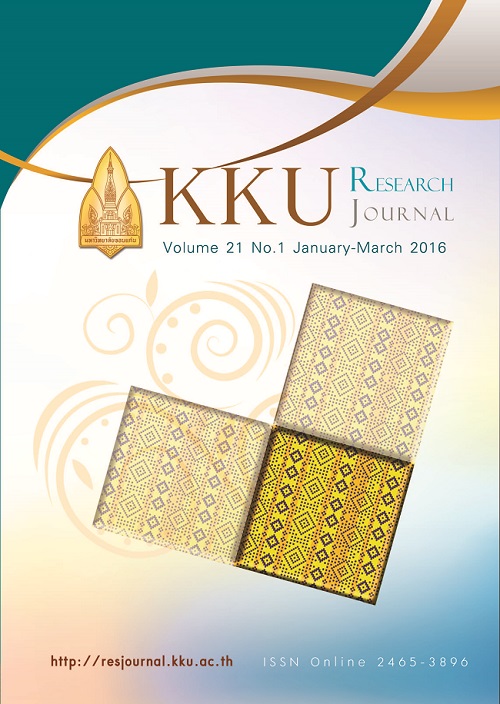Antioxidant activities and total phenolic content of multi-colored fruits and vegetables in Thailand
Main Article Content
Abstract
Fruits and vegetables are valuable sources of natural phenolic antioxidants which are known to have beneficial health promoting properties. The main objectives of this study were to compare the antioxidant activities and total phenolic and flavonoid contents of ten ethanolic edible plant extracts (Five species of fruits and vegetables) with varieties of colors.The result showed that purple color of plants, including ethanolic extracts of Brassica oleracea Linn. (40.7±0.56%) and Vigna sesquipedalis (4.52±0.01%) significantly showed the highest TPC and TFC compared with the same species and other species with different colors (p<0.01). Measurement of antioxidant capacity, yellow Capsicum annuum Linn. (58.72±0.52%) and purple Solanum melongena Linn. extract (22.44±1.20%) significantly showed the maximum antioxidant activities by DPPH radical scavenging activity assay and ferric ion reducing antioxidant power (FRAP) assay, respectively (p<0.01). Base on shades of color pigment extracts, green and red pigment had more potential antioxidant activities than other colors. The purple and yellow pigments showed the maximum total phenolic contents by Folin-Ciocalteu reagent. These results concluded that purple color of plants; Brassica oleracea Linn. and Vigna sesquipedalis in this study had the potential to be a suitable source of cheap phenolics and flavonoids as antioxidant compounds.
Article Details
References
[2] Patel VR, Patel PR, Kajal SS.Antioxidant activity of some selected medicinal plants in western region of India. Advan Biol Res.2010;4(1): 23-26.
[3] Jin Dai and Russell J Mumper, Plant phenolics: extraction, analysis and their antioxidant and anticancer
properties. Molecules. 2010;15: 7313-7352
[4] Li F, Bo-Tao X, Xiang-Rong X, Ren-You G, Yuan Z, En-Qin X, et al. Antioxidant capacities and total phenolic contents of 62 fruits. Food Chem., 2011;129(2): 345-350.
[5] Adhikarimayum H, Kshetrimayum G. Total Antioxidant capacity of twenty wild and cultivated fruits. Int J Agric Food Sci. 2012, 2 (4): 146-148.
[6] Karadag A, Ozeelik B, Saner S. Review of methods to determine antioxidant capacities. Food Anal
Method. 2009;2(1):41–60.
[7] Krout AA, Mighri H, Krid M, Thabet F, Turki H, El-Jani H, et al. Chemical composition and
antioxidant activity of aqueous extracts of some wild medicinal plants in Southern Tunisia. Int J Life
Sci Med Sci Res. 2012; 2(1):1-4.
[8] RashidaP, Naveed A. In vitro evaluation of antioxidant activity of phytochemical extracts from
different varieties of various plants. Asian J Chem. 2013; 25(18): 10561-10564.
[9] Manach C, Scalbert A,Morand C, Remesy C, Jimenez L. Polyphenols: food sources and bioavailability.
Am J Clin Nutr. 2004;79(5),727-747.
[10] Sun T, Xu Z, Wu CT, Janes M, Prinyawiwatkul W, No HK. 2007. Antioxidant activities of different colored sweet bell peppers (Capsicum annuum L.). J Food Sci. 2007;72(2):S98-102.
[11] Nurliyana R, Syed ZI, Mustapha SK, Aisyah MR, Kamarul RK. Antioxidant study of pulps and
peels of dragon fruits: a comparative study. Int Food Res J.2010;17:367-375.
[12] Mia I, Bee LL, Meng TL, Woon-Puay K, Dejian H, Choon NO. Antioxidant activity and profiles of common
vegetables in Singapore. Food Chem. 2010;120(4): 993-1003.
[13] Ranajit KS, Shafiqur R, AfandiA. Bioactive compounds in chilli peppers (Capsicum annuum L.) at
various ripening (green, yellow and red) stages. Ann Biol Res. 2013;4(8):27-34.
[14] Jae-Hee P, Gyeong-Im J, Jung-Mi K, Eunju P. Antioxidant activity and antiproliferative action of methanol
extracts of 4 different colored bell peppers (Capsicum annuum L.).2012;21(2):543-550.
[15] Breinholt V, Desirable versus harmful levels of intake of flavonoids and phenolic acids. In: J
Kumpulainen and J.E. Salonen, editor. Natural Antioxidants and Anticarcinogens in Nutrition Health
and Disease. The Royal Society of Chem., Cambridge, 1999.p. 190-197.
[16] Duthie GG, Duthie SJ, Kyle JA. Plant polyphenols in cancer and heart disease: Implications as
nutritional antioxidants.Nut. Res. Rev.2000;13(1): 79-106.
[17] Materska M, Perucka I. Antioxidant activity of the main phenolic compounds isolated from hot
pepper fruit (Capsicum annuum L.). J Agric Food Chem. 2005;53(5): 1750-1756.
[18] Ains worth EA, Gillespie KM. Estimation of total phenolic content and other oxidation substrates in
plant tissues using Folin- Ciocalteu reagent. Nat Protoc. 2007;2(4):875–877.
[19] Liu M, Li XQ, Weber C, Lee CY, Brown J, Liu RH. Antioxidant and antiproliferative activities of
raspberries. J Agric Food Chem. 2002;50(10): 2926-2930.
[20] Akowuah GA, Ismail Z, Norhayati I, Sadikun A, The effects of different extraction solvents of
varying polarities of polyphenols of Orthosiphon stamineus and evaluation of the free radicalscavenging
activity. Food Chem. 2005;93(2): 311-317.
[21] Benzie IFF, Strain JJ. The ferric reducing ability of plasma (FRAP) as a measure of ‘‘antioxidant
power’’: the FRAP assay. Anal Biochem. 1996;239(1): 70–76.
[22] Bunga T, Shankar GR, Janapatla S, Ramavath AK. Phytochemical antioxidant properties in green and
purple varieties of cabbage. World J P h a r m a R e s . 2 1 4 ; 3 ( 1 0 ) :1415-1425.
[23] Montoro P, Braca A, Pizza C, De Tommasi N. Structure-antioxidant activity relationships of flavonoids
isolated from different plant species. Food Chem 2005, 92: 349–355.
[24] Maria MBA, Paulo HMS, Angela MCA , Giovana MP, Carlos ECM , Geraldo AM, et al. Bioactive
compounds and antioxidant activity of fresh exotic fruits from Northeastern Brazil. Food Res Int. 2011;44(7):2155–2159.
[25] Lavanya R, Maheshwari S, Harish G, Raj B, Kamali S, Hemamalani D, et al. In-vitro antioxidant
activity of methanolic extract in leaves of Anisomeles malabarica Linn, Res J PharmBiolChem Sci. 2010;1(4): 737-744.


